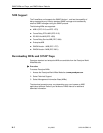
SNMP MIBs and Traps, and RMON Alarm Defaults
B-9
9123-A2-GB20-10
July 2000
Table B-6. linkUp and linkDown Variable-Bindings (1 of 2)
Interface
Variable-Bindings Possible Cause
Physical Sublayer
Network
(Supported by the
media-specific DS1
MIB.)
H ifIndex (RFC 1573)
H ifAdminStatus
(RFC 1573)
H ifOperStatus (RFC 1573)
H devLastTrapString
(devHealthAndStatus.-
mib)
H linkDown – One or more alarm
conditions are active on the
interface.
Alarm conditions include:
– Loss of Signal (LOS) or
far-end loss of signal
– Out of Frame (OOF)
– Alarm Indication Signal
(AIS)
– Excessive Error Rate (EER)
– Yellow Alarm
Strings:
‘$ifString down.’ No alarms
exist. (e.g., ‘Network T1 down
due to yellow alarm.’)
‘$ifString administratively
shutdown.’ (Due to an
intentional shutdown.)
H linkUp – No alarms on the
interface.
String:
‘$ifString up.’
Synchronous
Data Port
(Supported by the
media-specific
RS232-like MIB.)
H ifIndex (RFC 1573)
H ifAdminStatus
(RFC 1573)
H ifOperStatus (RFC 1573)
H devLastTrapString
(devHealthAndStatus.-
mib)
H linkDown – One or more alarm
conditions are active on the
port.
Alarm conditions include:
– DTR off
1
– RTS off
2
– ‘’ – Not DTR or RTS, but
link is down.
String:
‘$ifString $alarmString down.’
(e.g., ‘Sync Data Port S01P1
DTR and RTS down.’)
‘$ifString administratively
shutdown.’ (Due to an
intentional shutdown.)
H linkUp – No alarms on the
port.
String:
‘$ifString up.’
1
The DTR alarm condition will only generate a linkUp/linkDown trap if the DTE
supports the DTR lead state.
2
The RTS alarm condition will only generate a linkUp/linkDown trap if the DTE
supports the RTS lead state.


















